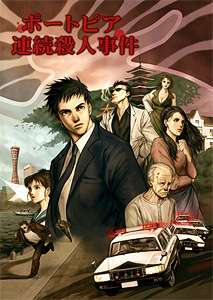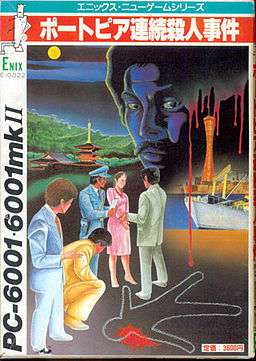The Portopia Serial Murder Case
| Portopia Renzoku Satsujin Jiken | |
|---|---|
|
Cover art of the NEC PC-6001 version | |
| Developer(s) | Chunsoft |
| Publisher(s) | Enix |
| Director(s) | Yuji Horii |
| Designer(s) | Yuji Horii |
| Writer(s) | Yuji Horii |
| Platform(s) | PC-6001, PC-8801, FM-7, FM-8, MSX, Sharp X1, Family Computer, Mobile (i-mode, EZweb, Keitai) |
| Release date(s) | |
| Genre(s) |
Adventure game visual novel |
| Mode(s) | Single-player |
The Portopia Serial Murder Incident,[lower-alpha 1] also known as The Portopia Serial Murder Case, is an adventure game designed by Yuji Horii and published by Enix (now Square Enix). It was first released on the NEC PC-6001 in June 1983, and has since been ported to other personal computers, the Famicom, and mobile phone services. In the game, the player must resolve a murder mystery by searching for clues, exploring different areas, interacting with characters, and solving item-based puzzles.
Horii was inspired to create the game after he read a magazine article discussing adventure games in the United States. He realized that the genre was not well established in Japan, and decided to design his own adventure game. Upon its release, The Portopia Serial Murder Incident was well received in Japan, and has become an influential title that helped define the visual novel genre.
Gameplay

The Portopia Serial Murder Incident follows a first-person perspective and narrative. The various events are described with still pictures and text messages. The player interacts with the game using a verb-noun parser which requires typing precise commands with the keyboard. Finding the exact words to type is considered part of the riddles that must be solved. While sound effects are present, the game lacks music and a save function.[1] It features a branching dialogue conversation system where the story develops through entering commands and receiving answers to them from the player's sidekick or non-player characters.[2]
The game allows multiple different ways to achieve objectives,[3] adding an element of nonlinear gameplay. This included travelling between different areas in a generally open world and making choices that determine the dialogues and order of events as well as alternative outcomes depending on who the player identifies as the culprit. However, only one of the characters is the true culprit, while the others are red herrings; if the player closes the case with the wrong culprit, then the player will face criticism from the police chief and need to re-open the case. The game includes a phone that could be used to manually dial any number, which is needed to contact several non-player characters.[2] The game also features an inventory system requiring the examination and collection of items, which could be used as evidence later in the game.[4]
With no keyboard, the Famicom version replaces the verb-noun parser with a menu list of fourteen set commands selectable with the gamepad.[1] This is similar to the command selection menu system introduced in Yuji Horii's murder mystery adventure game Okhotsk ni Kiyu: Hokkaido Rensa Satsujin Jiken, which was released in 1984,[5] in between the PC and Famicom releases of Portopia. One of the commands on the menu allowed the player to use the D-pad to move a cursor on the screen in order to look for clues and hotspots, similar to a point-and-click interface.[1] The Famicom version of Portopia also features branching menu selections, which includes using the pointer as a magnifying glass to investigate objects, which is needed to find hidden clues, and as a fist or hammer to hit anything or anyone, which could be used to carry out interrogation beatings on suspects.[2] Additional sequences were also added, notably an underground dungeon maze reportedly influenced by Wizardry,[1] giving those sequences a style similar to role-playing video games.[6]
Setting and characters
Although the story of the game is fictional, it is set in real Japanese cities; mainly Kobe, in addition to a few sequences in Kyoto and Sumoto.[1] The president of a successful bank company, Kouzou Yamakawa (山川耕造), is found dead by his secretary Fumie Sawaki (さわき ふみえ) inside a locked room in his mansion. Signs seem to indicate that Kouzou stabbed himself; however, the police sends a detective to investigate further.[7]
The detective in charge of the case is an unnamed, unseen, and silent protagonist who essentially embodies the player. He works with an assistant named Yasuhiko Mano (間野康彦), nicknamed Yasu (ヤス), who is the one who actually speaks and executes most of the player's commands.[1] Other characters include, among others, Yukiko (ゆきこ), daughter of a man named Hirata (ひらた); and Toshiyuki (としゆき), Kouzou's nephew and heir.[7]
Development and release

The game was conceived by Yuji Horii around 1981, when he was 27 years old, shortly after he bought his first computer and learned to program with it by modifying other games.[6] During this time, he read a PC magazine article about a computer game genre called adventure games in the United States. Horii noticed the lack of such games in the Japanese market and decided to create an adventure game of his own, one that was "a program in which the story would develop through entering a command and by receiving an answer to it."[6] The game was developed using the BASIC programming language.[8]
Following its 1983 release,[2] the game was ported to various Japanese personal computers.[9] A Famicom port was then released in 1985 and was the first adventure game to be released on that platform. The Famicom version was also the first collaboration between Yuuji Horii and Koichi Nakamura of Chunsoft, before Dragon Quest.[10] The Famicom version was programmed by Nakamura, who was 19 years old at the time. The game was never released in the Western world, largely due to its mature content, involving themes such as murder, suicide, fraud, bankruptcy, interrogation beatings, drug dealings, and a strip club.[2] The lack of a Western release prompted ROM hacking group DvD Translations to develop an unofficial translation of the Famicom version.[6]
The first mobile phone version of the game was branded as a part of a Horii Yūji Gekijō (堀井雄二劇場, "Yūji Horii Theater") trilogy along with mobile versions of Hokkaido Rensa Satsujin Okhotsk ni Kiyu and Karuizawa Yūkai Annai. It was released in 2003 on EZweb and Yahoo! Keitai services. It features a list of set commands similar to the Famicom version but also improved graphics, no free-moving cursor, and a save function.[9] The games of the trilogy, which was retitled Yuuji Horii Mysteries (堀井雄二ミステリーズ), were re-released in 2005 and 2006 on the same services. The second Portopia version possesses the same content as the first mobile one, in addition to updated graphics, background music, a bonus function obtained after completing the game, and a hint option which nullifies the ending bonus if it is used too frequently.[1][7]
Reception and legacy
The Famicom version of the game sold 700,000 copies.[1] The game was well received in Japan for allowing multiple ways to achieve objectives, its well-told storyline, and its surprising twist ending.[3] The Japanese press described it as "a game without game over" because "there was technically no way to lose."[6] According to Square Enix, it was "the first real detective adventure" game.[11] The game, along with Super Mario Bros., inspired Hideo Kojima (creator of the Metal Gear series) to enter the video game industry. He praised Portopia for its mystery, drama, humor, 3D dungeons, for providing a proper background and explanation behind the murderer's motives, and expanding the potential of video games.[12]
In 2003, The Portopia Serial Murder Incident ranked 19th in a poll to determine the thirty best Famicom games; the poll was conducted by the Tokyo Metropolitan Museum of Photography as part of its "Level X" exhibition.[13] The English-language webzine Retrogaming Times Monthly compared the game to the later-released Shadowgate where the player must examine and collect objects and find their true purpose later on, and recommended Portopia to fans of "slower paced games that require [players] to think through puzzles".[4] John Szczepaniak of Retro Gamer called the game simple, but praised its pacing and quality of writing,[6] and considers the gameplay and plot to be sophisticated for its time. He also considers it "one of the most influential games" as it was responsible for defining the visual novel genre, comparing it to the role of Super Mario Bros., Tetris and Street Fighter in defining their own respective genres (platform game, puzzle game, and fighting game, respectively). He noted that it contains elements found in later titles such as Snatcher, Déjà Vu, 428: Fūsa Sareta Shibuya de, and Nine Hours, Nine Persons, Nine Doors.[2] 1UP.com also noted that Portopia is very similar to ICOM Simulations' Déjà Vu released several years later and that Horii's own seminal role-playing game Dragon Warrior used storytelling techniques and a menu-based command system very similar to Portopia.[14] Nintendo's successful Famicom Detective Club series of adventure games were also inspired by Portopia.[15]
References
Notes
- ↑ The game is known in Japan as Portopia Renzoku Satsujin Jiken (ポートピア連続殺人事件).
Footnotes
- 1 2 3 4 5 6 7 8 Gameman (2005-09-06). 「ポートピア連続殺人事件」の舞台を巡る. ITmedia +D Games (in Japanese). ITmedia. p. 1. Retrieved 2007-08-16. (Translation)
- 1 2 3 4 5 6 Szczepaniak, John (February 2011). "Portopia Renzoku Satsujin Jiken". Retro Gamer. Retrieved 2011-03-16. (Reprinted at John Szczepaniak. "Retro Gamer 85". Hardcore Gaming 101. Retrieved 2011-03-16.)
- 1 2 Szczepaniak, John. "Retro Japanese Computers: Gaming's Final Frontier". Hardcore Gaming 101. p. 3. Retrieved 2011-03-16. Reprinted from "Retro Japanese Computers: Gaming's Final Frontier", Retro Gamer (67), p. 2009
- 1 2 Jacobi, Scott (October 2006). "Nintendo Realm - November to December 1985". Retrogaming Times Monthly (29). Retrieved 2007-08-16.
- ↑ "北海道連鎖殺人 オホーツクに消ゆ". Enterbrain. Archived from the original on 2003-08-01. Retrieved 2011-09-20. (Translation)
- 1 2 3 4 5 6 Szczepaniak, John. "Before They Were Famouos". Retro Gamer. Imagine Publishing (35): 76.
- 1 2 3 ポートピア連続殺人事件 (in Japanese). Square Enix. Retrieved 2007-08-16.
- ↑ Szczepaniak, John (2014-04-28). "BASIC's 50th anniversary draws near". Gamasutra. Retrieved 2015-01-12.
- 1 2 "事件だヤス! iモード「ポートピア」配信開始". ITmedia +D Games (in Japanese). ITmedia. 2001-11-26. Retrieved 2007-08-16.
- ↑ Ryozo, Ota (2005-01-13). "「ポートピア連続殺人事件」にグラフィックなどを一新したBREW版". ケータイ (in Japanese). Impress Group. Retrieved 2007-08-16.
- ↑ "ポートピア連続殺人事件". Square Enix. Retrieved 2016-10-15.
- ↑ Kasavin, Greg (2005-03-21). ""Everything is Possible": Inside the Minds of Gaming's Master Storytellers". GameSpot. CBS Interactive. Retrieved 2015-12-27.
- ↑ "Japanese Famicom Top 30". 1UP.com. Ziff Davis. 2000-01-01. Archived from the original on 2015-08-15. Retrieved August 15, 2015.
- ↑ "East and West, Warrior and Quest: A Dragon Quest Retrospective - An anniversary look back at the most influential console RPG ever made". 1UP.com. May 2011. p. 2. Archived from the original on 2011-12-21. Retrieved 2011-12-28.
- ↑ Parish, Jeremy (2013-03-21). "Review: Bending Genres in Luigi's Mansion: Dark Moon". 1UP.com. Retrieved 2015-01-12.
External links
- Famicom version official page (Japanese)
- Second mobile version official websites: EZweb, i-mode, Keitai (Japanese)
